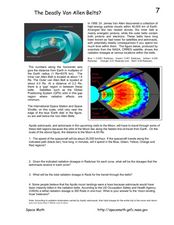DocsTeach
Apollo-Soyuz: Space Age Detente
The Space Race saw the Soviet Union and the US go from competitors to partners. Scholars read a letter regarding the first docking of the US and Soviet space craft. Young historians also complete a written assignment and participate in...
Curated OER
Apollo Moon Landing
Students explore paper rockets, learn about the Apollo Program and Apollo spin-offs, and use simple office supplies to design and create a new useful product. This amazing plan is incredibly well written and leads students through a...
Mr. E. Science
Manned Space Exploration: From Apollo to Present
How did the manned space mission program progress? The presentation covers American space exploration from the Apollo missions through the International Space Station.
American Museum of Natural History
Field Trip: Space Flight
Take a virtual trip to infinity and beyond. Pupils watch a space visualization that leaves Earth and heads to the ISS and then follows the Apollo missions to the moon. Scholars view detailed images of the space station and its different...
Mr. E. Science
Manned Spaced Exploration: From Start to Gemini
Seven percent of Americans believe the moon landing was staged. The presentation covers manned space exploration from the beginning of the space race through the Gemini missions. The lesson is the 23rd in a set of 26.
Curated OER
Space Exploration
Students explore the significance of the four space programs: Sputnik, Apollo, Viking, and Voyager. In this space exploration lesson, students view a space exploration slideshow and complete an included chart of space exploration.
Curated OER
The Big Arm
In this "The Big Arm" worksheet, students answer multiple choice questions about "The Big Arm" and the space shuttle that launched it. Students complete 4 questions.
Curated OER
Space Search
In this space worksheet, students identify and locate vocabulary terms and names related to space. There are 26 words located in the puzzle.
Curated OER
Women In Space: Sally Ride
Second graders explore the life and accomplishments of Sally Ride, the first American woman in space. Through reading and discussion, they recall details from Sally Ride's life.
University of Colorado
Distance = Rate x Time
Every year, the moon moves 3.8 cm farther from Earth. In the 11th part of 22, classes use the distance formula. They determine the distance to the moon based upon given data and then graph Galileo spacecraft data to determine its movement.
John F. Kennedy Library Foundation
JFK Challenge
And so, my fellow Americans: ask not what your country can do for you—ask what you can do for your country. And so begins your invigorating, innovative learning experience in the JFK Challenge app! Learners...
Messenger Education
Mission: Possible—How Can We Plan an Exploration of Another World?
An astronaut's spacesuit weighs 280 pounds and takes 45 minutes to put on — that's a serious suit! The second activity of a three-part series allows pupils to see all that goes into space exploration. Through simulations, groups analyze...
Curated OER
Apollo 16
Students examine Apollo 16 and its significance. In this Apollo 16 lesson students work in groups, answer questions and complete a worksheet.
Curated OER
Space Trading Cards
Learners use the Internet and other reference sources to gather information on a space topic. They create a trading card displaying the information learned and import pictures from libraries and the Internet.
Curated OER
What is Momentum?
In this momentum activity, students will calculate the maximum forward momentum of the Apollo 11 lunar spacecraft at three different stages of its space travel.
Curated OER
The Deadly Van Allen Belts?
In this Van Allen Belts worksheet, students read about the deadly affects of the high energy particle clouds located around the Earth. Students answer 4 questions about the dosages of radiation astronauts receive in the zones of the Van...
Curated OER
Having a Hot Time on Mars!
For this cosmic radiation on Mars worksheet, students study a radiation map of Mars taken by the MARIE instrument on the Odyssey spacecraft. Students answer 4 questions using the radiation map and they answer questions about the exposure...
Curated OER
Mission Impossible! Are We Alone in the Universe, or Are We Just One of Its Citizens?
Students examine NASA strategy for scientifically studying any celestial body. They brainstorm about all previous space explorations and missions they can recall, and propose an expedition plan to become space explorers of the future.
Curated OER
Rocketry
Young scholars design and construct a paper rocket that can be launched with a drinking straw. They participate in a lecture and read an article about rocketry and how Newton's Third Law applies to rocket launches. Each student...
Curated OER
Life on the Moon
Students study the physical properties of the Moon. In this life on the moon lesson students describe the ways life on the Moon would be different than on Earth.
Messenger Education
Exploring Exploring
The reason people first began trading was because of their desires for objects other societies possessed. In the activity, classes discuss why exploration has been a common thread in all societies and where these desires have taken...
NASA
Packing for a L-o-o-o-ng Trip to Mars
Pack just enough to fit. Crews determine what personal items to take with them on a trip to Mars. Each team must decide what to take with them on a two-and-a-half year trip to Mars and whether their items will fit within the allotted...
Curated OER
Atmospheric Shielding from Radiation I
In this radiation worksheet, students calculate the distance of a satellite in orbit to determine the placement of a radiation detection device. This worksheet has 2 problems to solve.
Curated OER
Atmospheric Shielding from Radiation III
In this radiation worksheet, students compare the efficiency of planetary atmospheres to shielding from radiation. This worksheet has 2 problems to solve.

























